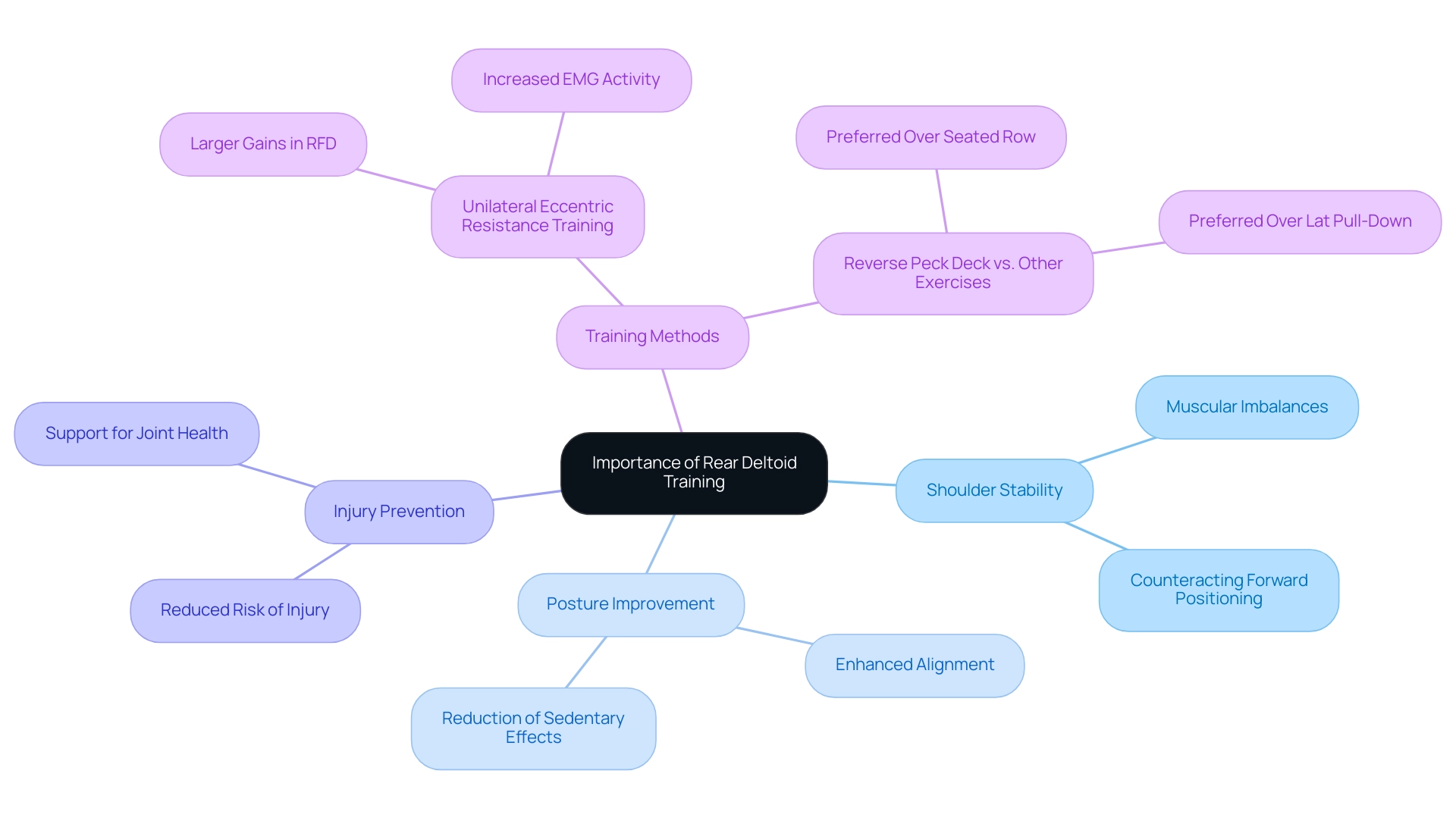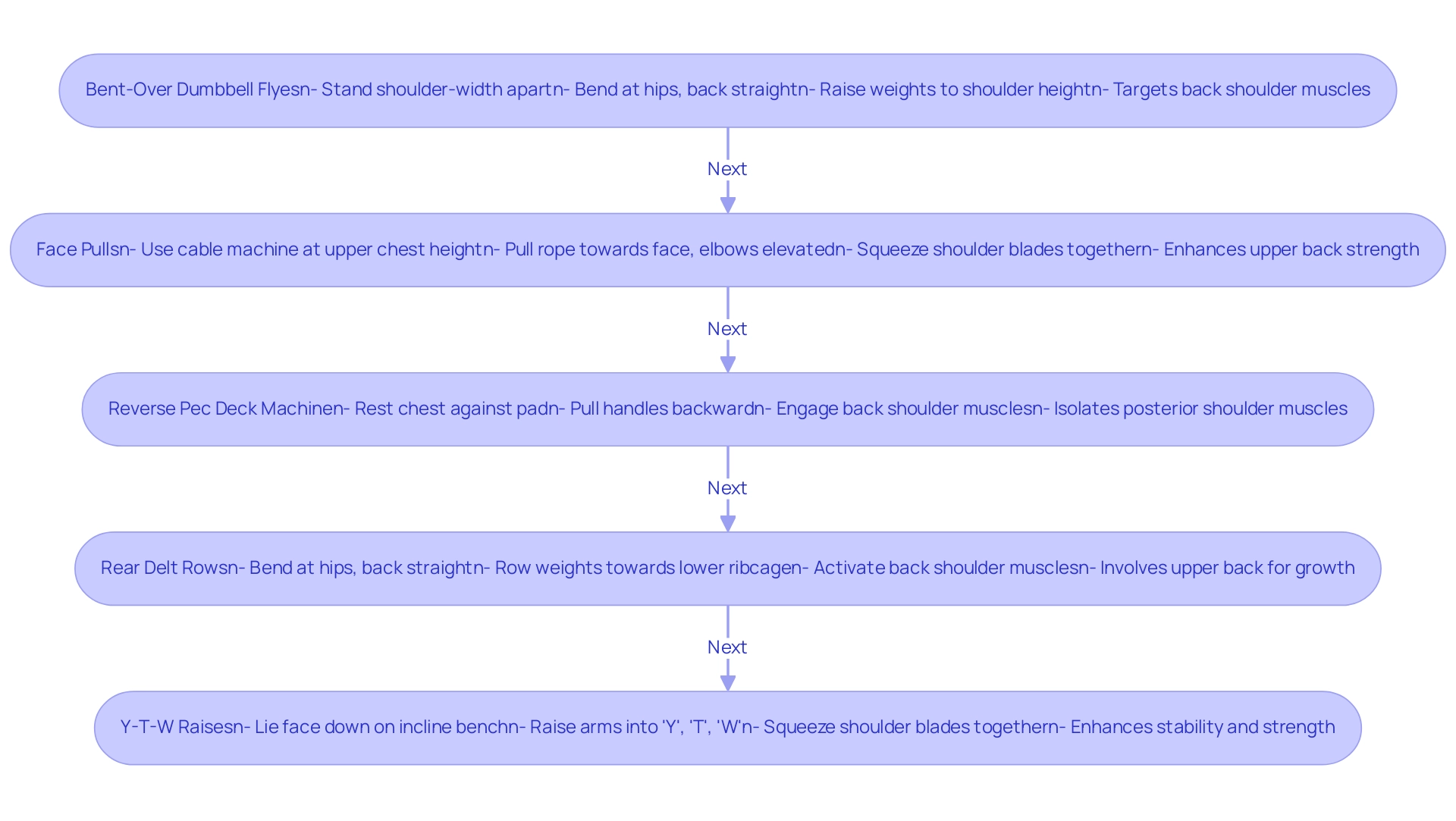Introduction
The rear deltoids often find themselves overshadowed in the realm of shoulder training, yet their significance cannot be overstated. These muscles are essential not only for achieving balanced shoulder aesthetics but also for ensuring stability and preventing injuries that can arise from muscular imbalances.
Many traditional workout routines focus heavily on the anterior and lateral deltoids, leaving the rear deltoids neglected and underdeveloped. This article delves into the critical role of rear deltoid training, offering insights into:
- Effective exercises
- Common pitfalls to avoid
- Strategies for incorporating these movements into a comprehensive fitness regimen
By understanding and prioritizing rear deltoid development, individuals can enhance their overall shoulder health, improve posture, and bolster performance in various physical activities.
1. The Importance of Rear Deltoid Training for Shoulder Development
The posterior shoulder muscles are essential for sustaining shoulder stability, improving posture, and encouraging overall shoulder growth. In contrast to the front and side shoulder muscles, which often dominate traditional training routines, rear delt exercises for the back shoulder muscles are frequently overlooked. This neglect can lead to muscular imbalances that heighten the risk of injury.
Enhancing the posterior shoulder muscles with rear delt exercises not only leads to a more visually appealing shoulder look but also boosts performance in different physical activities. A well-developed posterior shoulder area plays a significant role in counteracting the adverse effects of prolonged forward shoulder positioning, which is increasingly common in sedentary lifestyles. As mentioned by Ronei S Pinto,
Conversely, the reverse peck deck should be primarily utilized instead of the seated row and the lat pull-down for engaging the posterior part of the shoulder.
Furthermore, recent studies indicate that unilateral eccentric resistance training modalities yield larger gains in rapid force development (RFD), mechanical work, and electromyographic (EMG) activity compared to traditional methods, with significant improvements observed (p < .05, 1.25 ≤ d ≤ 2.79). Moreover, the research named '
Limitations and Future Research Directions' highlights the necessity for additional exploration into the effectiveness of different training methods on posterior shoulder muscle activation, especially in competitive bodybuilders. It also emphasizes important distinctions in anterior shoulder muscle activity between workouts, reinforcing the unique function of posterior shoulder training in shoulder stability.
Considering these factors, incorporating rear delt exercises is not just advantageous but crucial for a comprehensive strategy to shoulder training, assisting in both injury prevention and enhanced posture.
2. Top Exercises for Maximizing Rear Delt Gains
-
Bent-Over Dumbbell Flyes: To carry out this movement, begin by standing with your feet shoulder-width apart. Bend at the hips while keeping your back straight, and hold a dumbbell in each hand with a slight bend in your elbows. Raise the weights out to the sides until they reach shoulder height, maintaining parallel alignment with the floor. Lower the weights back down in a controlled manner. This movement effectively targets the back shoulder muscles, making it a cornerstone for
rear delt exercises and overall shoulder development.
-
Face Pulls: Utilizing a cable machine, adjust the pulley to a height level with your upper chest. Step back and grasp the rope attachment with both hands. As you pull the rope towards your face, ensure your elbows remain elevated and actively squeeze your shoulder blades together. This exercise is especially effective for focusing on rear delt exercises, which enhance upper back strength and are essential elements for shoulder stability.
-
Reverse Pec Deck Machine: Position yourself at the reverse pec deck machine, resting your chest against the pad. Grasp the handles and pull them backward in a controlled motion. Concentrate on engaging the back shoulder muscles while performing rear delt exercises throughout the movement. This machine offers an outstanding setting for isolating the posterior shoulder muscles, ensuring effective targeting of these muscles.
-
Rear Delt Rows: For this compound movement, use either a barbell or dumbbells. Bend at the hips while keeping your back straight, then row the weights toward your lower ribcage. Highlight the importance of activating the back shoulder muscles during the lift. This activity not only focuses on the back shoulder muscles but also includes rear delt exercises, involving the upper back and aiding in comprehensive shoulder growth.
-
Y-T-W Raises: Lie face down on an incline bench for this activity. Sequentially raise your arms into the 'Y', 'T', and 'W' positions, ensuring to squeeze your shoulder blades together at each stage. This activity is beneficial for enhancing stability and strength in the rear deltoids and upper back.
Incorporating a diverse array of rear delt exercises into your regular workout routine will significantly bolster rear deltoid strength, while also promoting overall shoulder health and performance. As emphasized by fitness professionals, concentrating on efficient activities not only boosts workout efficiency but also improves commitment to fitness routines over time. By identifying the most effective moves for the shoulders, ACE’s hope is that exercisers can be more time efficient with their workouts and, thus, more likely to stick with them for the long term.
Additionally, it is important to consider that the least optimal ratio for Shoulder Shrug was found to be 4.41, which emphasizes the need for balanced shoulder development. The research by Wattanaprakornkul (2011) further validates the effectiveness of these activities by evaluating upper trapezius and lower trapezius activation during similar movements.
3. Common Mistakes to Avoid in Rear Delt Training
-
Neglecting Warm-Up: Skipping a warm-up before participating in posterior shoulder movements can significantly heighten the chance of injury. Implementing dynamic stretches not only prepares the muscles for the workout but also enhances overall performance. Experts stress that appropriate warm-up routines are essential for injury prevention, especially during rear delt exercises that focus on the back shoulder muscles. As noted by Karl and Golas, further analysis of training techniques is essential to verify movement characteristics involved in these exercises.
-
Using Excessive Weights: A common mistake among enthusiasts is the tendency to lift weights that exceed their capabilities, which often leads to compromised form. Focusing on technique rather than the weight lifted is crucial for effectively performing rear delt exercises and reducing injury risk. Research indicates that improper weight selection can lead to heightened injury rates, especially when form is sacrificed. In fact, significant differences in the medial shoulder muscle activation were observed with a p-value of 0.001 and an effect size of 2.90, highlighting the importance of proper technique.
-
Inadequate Range of Motion: Performing delt exercises with limited range of motion diminishes their effectiveness. To fully engage the posterior deltoids during rear delt exercises, it is imperative to complete the entire movement. Research indicates that insufficient range of motion not only decreases activation of the tissues but can also lead to long-term injuries due to improper development. The
mind-muscle connection is crucial here; concentrating on the rear delt exercises throughout the movement leads to better performance and results, as emphasized in the case study on rear delt raises.
-
Not Incorporating Variety: Regularly doing the same activities can lead to training plateaus, hindering growth. To promote ongoing development, it is advisable to regularly vary your routine. Including supportive activities, like the shoulder press and lateral raise, can improve activation and engagement across various shoulder regions. The inclusion of these exercises is backed by findings that show significant differences in medial shoulder activation between lateral raises and other activities.
-
Overtraining: While adhering to a steady training routine is essential, excessive training of the back shoulder muscles can result in exhaustion and following injuries. It is essential to allow adequate recovery time between workouts that emphasize these groups. Recognizing the signs of overtraining and adjusting workout frequency accordingly can help in preventing injuries, thus promoting sustainable progress.
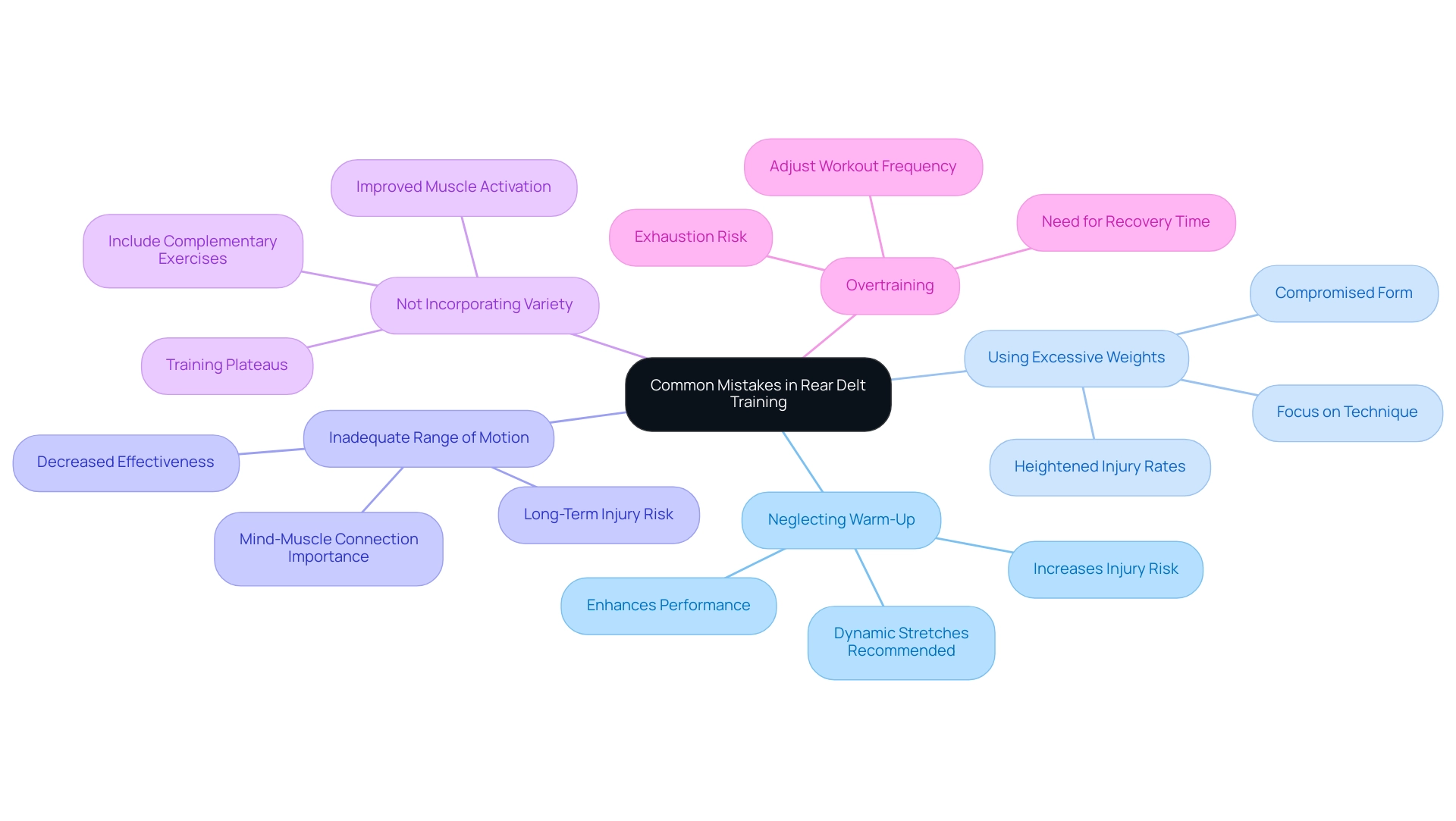
4. Incorporating Rear Delt Exercises into Your Workout Routine
-
Frequency: It is advisable to include rear delt exercises to train your rear shoulder muscles 1-2 times per week as part of an upper body regimen. This frequency promotes optimal muscle growth while allowing sufficient recovery time. A recent study emphasizes that each shoulder muscle head can effectively handle 8-12 total sets per week, split into 3-4 sets across 2-3 sessions. Specifically, incorporating
rear delt exercises like the Bench Supported Reverse Flye during these sessions can be advantageous, as this movement focuses on the posterior deltoids directly.
-
Placement in Routine: When structuring your workout, position rear delt exercises, such as the Bench Supported Reverse Flye, towards the end, following larger muscle groups like the chest and back. This approach ensures that you can allocate adequate energy and focus to these targeted activities, enhancing their effectiveness. Furthermore, incorporating the Pin Press sooner in your routine can aid in preparing your shoulders for more targeted delta work.
-
Supersets and Circuits: To enhance workout efficiency, consider integrating rear delt exercises into supersets or circuits with other upper body movements, such as the bench press. This strategy not only maintains your heart rate elevated but also incorporates rear delt exercises to enable a thorough upper body workout, maximizing engagement and accommodating the side and rear deltoids' capacity for higher training volume.
-
Progressive Overload: Implement progressive overload by gradually increasing weights or repetitions as your strength increases. This method is crucial for continually challenging your body, which is essential for promoting ongoing growth and development.
-
Recovery and Nutrition: Post-workout recovery is vital for muscle repair and growth. To enhance your results, consider the personalized nutrition support available at Awesome Health Club, including free consultations with Certified Nutritionists. Getting connected with a Certified Nutritionist can guide you in consuming adequate protein and nutrients to support recovery, alongside proper hydration. According to Mike Dewar, founder of J2FIT, a structured approach to recovery and nutrition, especially tailored to your individual needs, plays a pivotal role in achieving optimal performance and results. By concentrating on your particular workout plan, a Certified Nutritionist can assist in making sure your nutrition aligns with your objectives for developing your rear delt exercises.
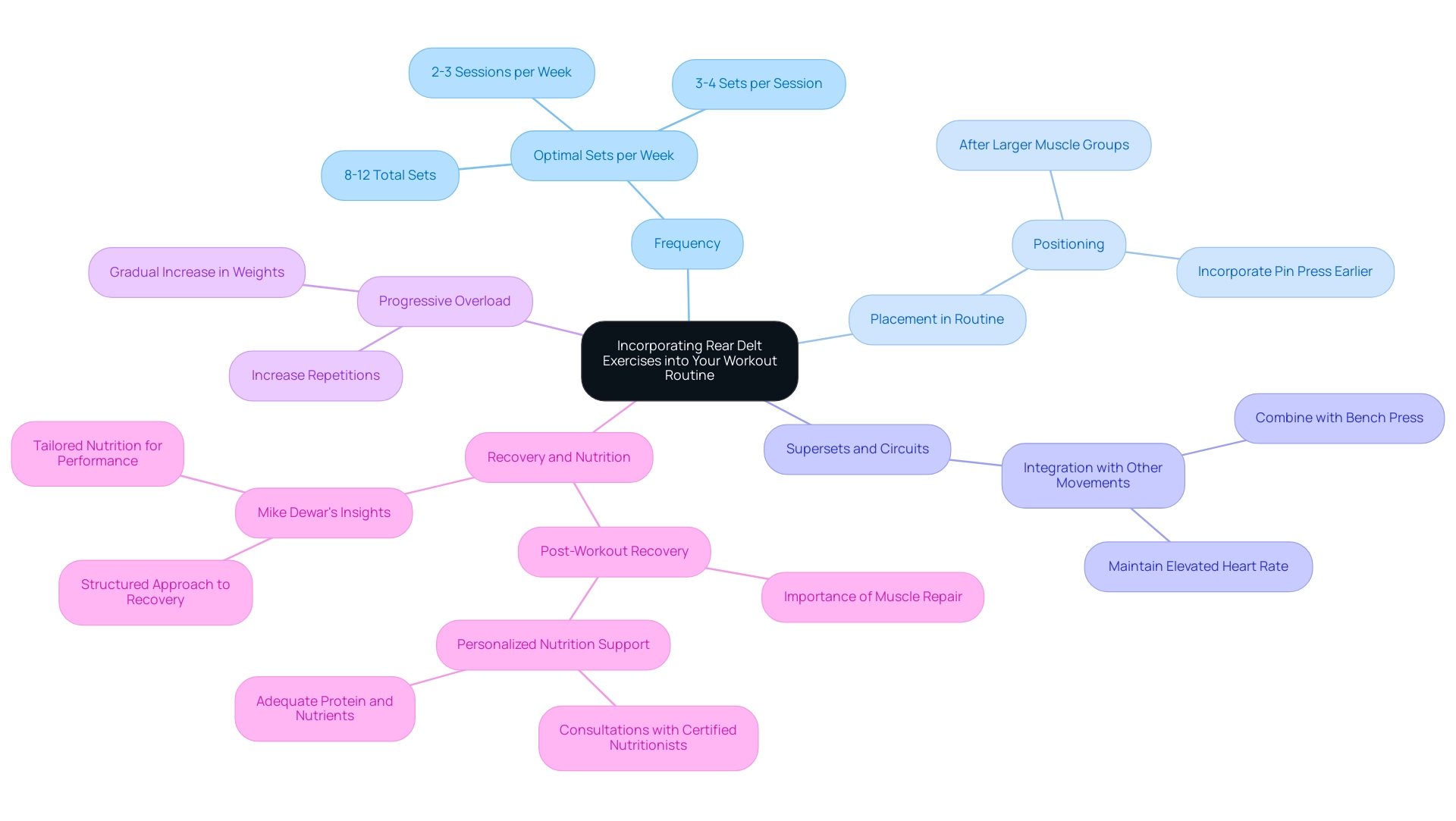
5. Tracking Progress in Rear Delt Development
-
Establish Specific Goals: Begin by setting clear, measurable objectives for your rear delt exercises, such as increasing the weight lifted in particular movements or the number of repetitions performed. Research indicates that goal setting is a critical component of successful fitness regimes, as it provides direction and motivation.
-
Maintain a Detailed Workout Log: Keeping a comprehensive record of each workout session is paramount. Document the exercises performed, weights lifted, sets completed, and repetitions achieved. This systematic tracking allows for the identification of progress trends, enabling you to pinpoint areas that require further attention or adjustment.
-
Incorporate Progress Photos: Visual documentation through progress photos can serve as a powerful motivational tool. These images can reveal changes in physical development that numbers alone may not convey, fostering a more comprehensive understanding of your progress.
-
Conduct Regular Assessments: Schedule evaluations of your strength and physical development every 4 to 6 weeks. These assessments are crucial for determining the effectiveness of your training regimen and for making necessary adjustments to optimize results. Engaging in a de-load week after intense lifting periods is also advisable; if you have not taken a break for more than four weeks, consider incorporating this to prevent burnout and promote recovery. This practice aligns with the insights from the case study titled "Periodization and Programming With VBT," which emphasizes the importance of structured recovery in optimizing strength training outcomes.
-
Address Protein Intake with Pea Protein: Many individuals struggle to meet their daily protein targets, especially while fasting or on a lower calorie intake. Incorporating pea protein into your diet can be an effective solution, as it is a sustainable, ethical, and vegan-friendly option that supports recovery and growth, particularly for those engaging in rear delt exercises. Pea protein provides essential amino acids, including branched-chain amino acids (BCAAs), which are vital for muscle recovery and growth. Additionally, it helps boost energy and focus, ensuring you stay motivated during workouts. For optimal results, consider trying our Protein Coffee, which combines the benefits of pea protein with a delicious coffee flavor, making it an easy addition to your daily routine.
-
Seek Professional Feedback: Collaborating with a trainer or fitness professional can provide valuable insights into your form and overall progress. Their guidance can help you refine techniques and stay accountable to your goals. As noted by fitness expert Greg O'Gallagher,
The simple act of paying attention to what you do will allow for you to make connections you never did before, and you will make continuous steady progress – almost without any extra effort.
This principle underscores the importance of being engaged and reflective in your training process.
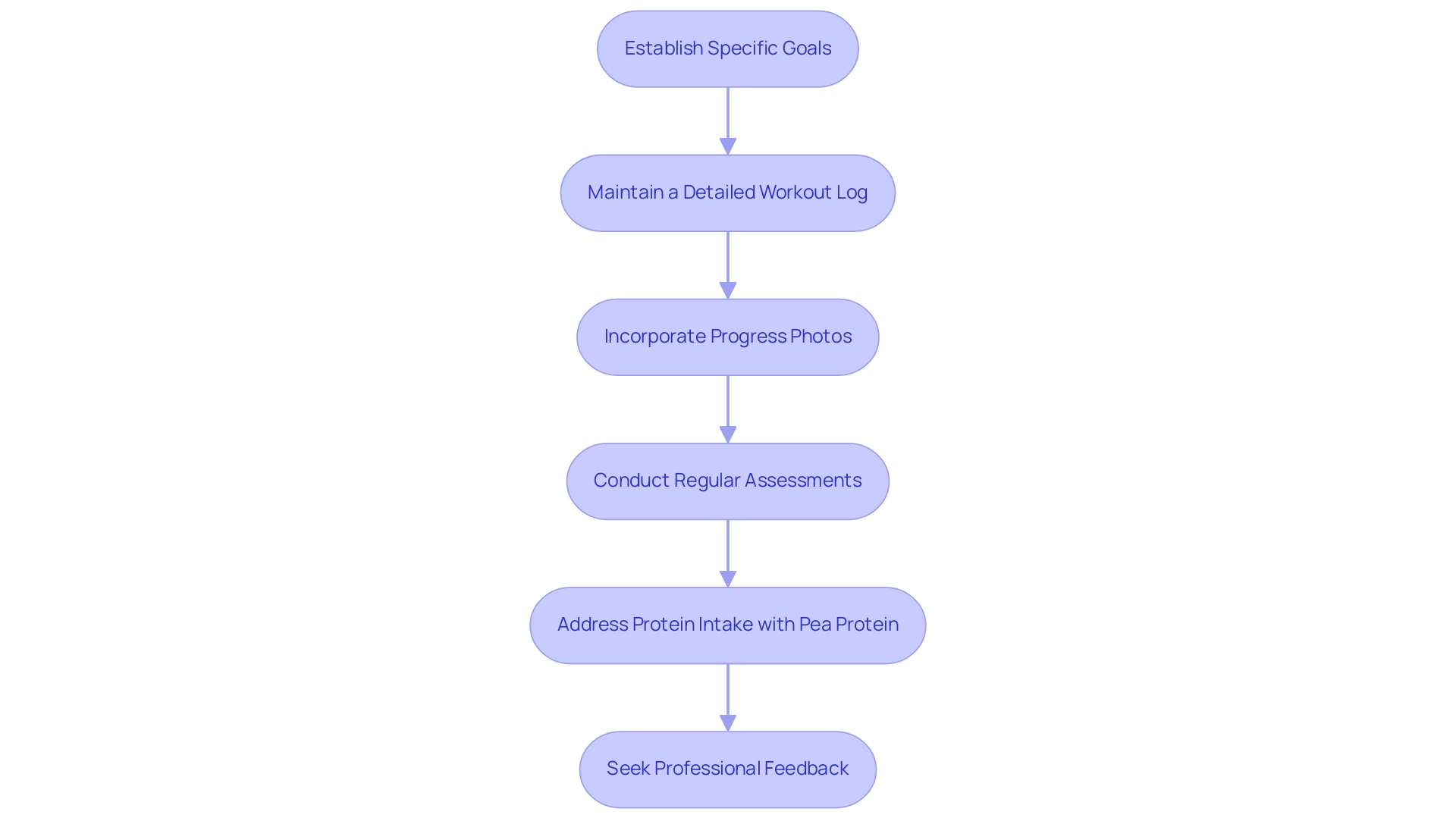
Conclusion
Rear deltoid training is an essential component of a well-rounded shoulder workout, offering numerous benefits that extend beyond aesthetics. By prioritizing the rear deltoids, individuals can achieve better shoulder stability, improved posture, and enhanced performance in various physical activities. Effective exercises such as:
- Bent-over dumbbell flyes
- Face pulls
- Rear delt rows
when incorporated into a regular training routine, can lead to significant gains in strength and muscle development.
However, it is crucial to avoid common pitfalls that can hinder progress. Neglecting warm-ups, using excessive weights, and failing to maintain a full range of motion can detract from the effectiveness of rear deltoid exercises. Additionally, varying routines and allowing for adequate recovery are vital in preventing overtraining and ensuring continuous improvement.
Incorporating rear delt exercises into a structured workout regimen requires thoughtful planning, including appropriate frequency, exercise placement, and progressive overload. Tracking progress through specific goals, detailed logs, and regular assessments can further optimize results. By recognizing the unique role of rear deltoids in shoulder health and performance, individuals can take proactive steps towards achieving balanced shoulder development and reducing the risk of injury. Prioritizing rear deltoid training is not just beneficial; it is essential for anyone serious about their fitness journey.
